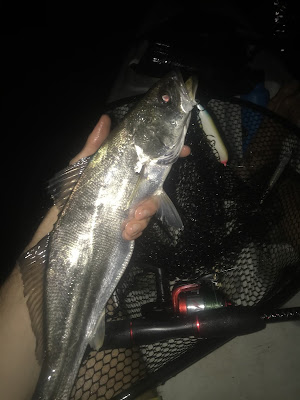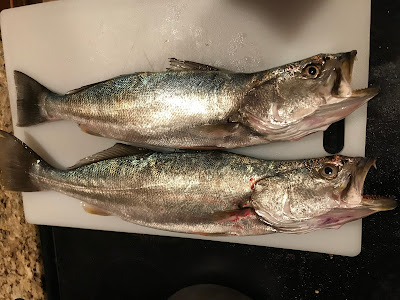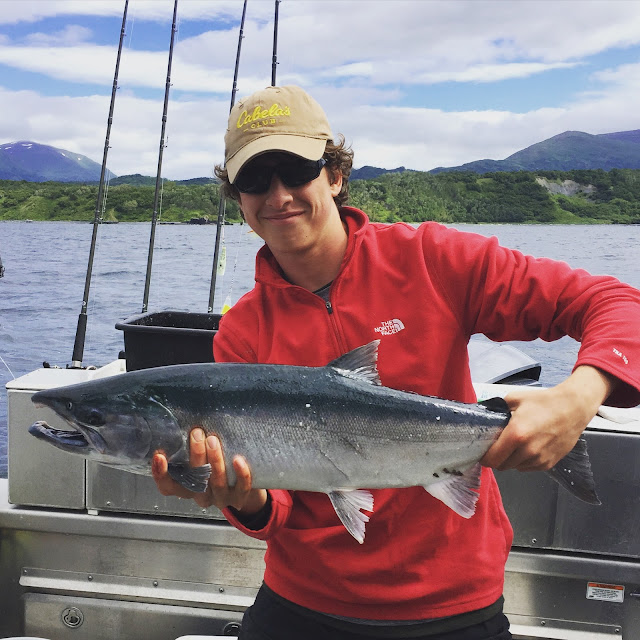Vampire Diaries - The Shortfin Corvina
However, they can be tricky to target. They often feed the most aggressively in the dead of night, and plan their movement and feeding around seasonal baitfish species that can themselves be tricky to locate. A spot with a wide open bite one night may be completely dead the next. Many people that fish San Diego have never heard of or caught them, and the guys that are serious about these fish want to keep it that way. This fish is responsible for a lot of drama. I've seen 30 page arguments on fishing forums debating whether or not it's acceptable to keep one, lots of localism, blurring out backgrounds, and online hate involving "spot burning." I've even heard about fights involving this fish. This fish is none other than the Shortfin Corvina.
Despite the "Cult of the Vina" and its exotic-sounding name, Corvina aren't too much different from the members of the Seatrout clan ubiquitous on the Gulf and East Coast. In fact, a Corvina is probably best described as a Speckled Trout without the spots. I took a buddy from Louisiana Vina hunting one night, and I didn't think he was as thrilled as I was to be casting topwater plugs for hours without much luck until nightfall hit and we caught what he ignominiously referred to as "Sand Trout." To be fair, he grew up in a fishery where the Vina's Atlantic counterpart was so common you could reliably count on sacking up on a limit of fish most times you went out. Targeting the big "Gator Trout" is of course a completely different ballgame, but the average size 10-16" Vina we were getting didn't seem worth the hassle to him. To many West Coast anglers, though, these fish are totally worth the hassle. Beautiful to look at, a satisfying challenge to crack, and exciting to fish for.
Like most of the fish I've put time into targeting since moving here, I don't have Vina dialed in. I won't pretend I do. I've only caught one that I would consider to be big, and some more experienced members of the Vina Cult would probably scoff at my definition of a big one. I also know that many would get irritated if I started talking about spots and specific techniques, and out of respect for them I won't. What I will say though is that these fish aren't as hard to catch as people think they are. Most people just don't put the time into the right techniques for bagging them.
Most casual bay fishers in San Diego almost exclusively target Spotted Bay Bass. I love Spotties. What they lack in size they make up for in spirit and pound-for-pound muscle, and their willingness to hit artificial baits such as swimbaits, jigs, and grubs make them fun to target. However, it's hard to have consistent Vina success if you only target Spotties. Spotties will hit a wide variety of baits and retrieves, but the easiest and most consistent method for getting bites is the "low and slow" method with a subtle-colored swimbait or dropshot. Over the course of doing that for awhile, you might get lucky and incidentally catch a vina. It happens quite a bit.
However, if you want to improve your chances you have to put time into throwing a shiny surface-oriented bait with a little more motion. Jerkbaits, shallow-diving crankbaits, topwater, etc. You'll get fewer bites doing this than with a swimbait, and success fishing these hardbaits is more conditions-dependent, but if you keep throwing a lure like a luckycraft or rapala enough times you'll eventually get a Vina. When I first started using them, I'd make a handful of casts without bites before giving up and going back to the Spottie gear. The very first time I decided I would fish "hardbaits or bust" I caught a Vina after a few hours of repeated casting. They move around a lot, and can be found in a lot of unexpected spots. This holds especially true during the warmer months, when the Vina invade vast areas of the bay and surf and are often found in some of the most popular, heavily fished areas.
Catching a stray Vina and consistently catching numbers of them are very different. This is where the spot secrecy really comes in, because there are specific factors that will make Vinas congregate and feed aggressively within a certain area. Sometimes it's seemingly random. Other times it's because of a very specific event you can almost set your clock with. However, simply knowing where to go isn't necessarily enough. As aforementioned, a spot that can be wide open one night can be dead the next. This can make it especially difficult to figure out where they're at, as it's easy to rule a spot out after giving it a few unsuccessful tries. I was lucky enough to receive some intel from fishing buddies on good places to target them. However, there's also some info I learned myself from long hours repeatedly casting or trolling hardbaits until I got lucky. Once again, I'm no expert. That being said, here's a few tips for those looking for some Vina-catching information that may not be readily available in other online sources:
-Pay attention to what they're eating. At certain times of year, or even on certain days, they'll be after baitfish as long as or twice as long as your finger. I've caught even small 8-10'' Vinas on 5-6'' baits during these times. Some of California's notorious big swimbait fishermen have even had consistent success catching monster Vinas on big Largemouth Bass swimbaits. During other times, they've been keyed in on really little 2-3'' baitfish (or even smaller) and it makes sense to adjust your lure size accordingly. I once had my kayak surrounded by boiling fish that wouldn't bite my 6'' Luckycrafts. The next day, I did a lot better using the smallest hardbaits I could find. Some were even too small to cast effectively without specialized ultralight trout tackle, so I primarily trolled using either one or two rods.
-Don't horse them in when they're hooked. Unless they have lots of hooks in their face their soft mouths will easily tear and send the lure flying back at you.
-Reaction bites happen a lot, especially when searching for scattered fish. To maximize efficiency in areas that may not be holding I usually do a steady retrieve. In areas where fish are congregating and busting bait on the surface a twitch-twitch-pause (or some variation) often works better.
-They aren't the best swimmers, at least not when compared to other predatory surface fish like members of the tuna and jack family. This can be seen by examining their tails; most fish designed for constant, fast swimming have forked tails (e.g. Yellowtail, Bonito, Tuna, Barracuda) while Vinas have fantails better designed for short bursts of speed. They often rely on choke points such as points, drop offs, docks, and boat hulls to corral baitfish and make them easier to catch. For this reason slower retrieves often work better than burning your bait back in like when Bonito or Cuda fishing.
-Use stealth to your advantage. They feed in shallow water and can be easily spooked, especially before they really get going and even more so once a couple of their buddies have been already caught.
-Fishing pressure will scare them away, but they don't usually go far. Some of the more well known spots get blown up and hit hard, but I've sometimes managed to find fish a short ways away in my kayak around some other structure and choke points.
Vina hunting is a challenge and can make for some of the most exciting fishing available to shore and kayak anglers. Remember to release as many as possible, as San Diego's Corvina population isn't particularly large and putting them back in good condition will undoubtedly improve the quality of the fishery. I emphasize the "as possible" part, because they are very fragile fish that don't respond well to handling and netting (particularly the smaller ones). If you catch a Corvina that's badly bruised, torn up, hooked badly and/or bleeding, you might as well keep it, since they are one of the best eating fish available in California waters. If you plan on releasing one, make sure to handle it as little as possible and take some time to revive it -especially a bigger fish that may have taken longer to land. Lastly, if any of you figure out a better way to land them from a kayak than by using a net, let me know. Treble hooks, mesh, and a thrashing, flopping fish are a terrible combination.

















Comments
Post a Comment